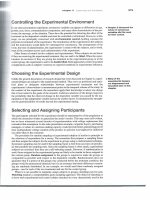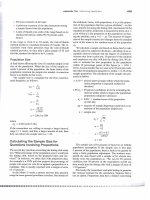Safe carrying methods
Bạn đang xem bản rút gọn của tài liệu. Xem và tải ngay bản đầy đủ của tài liệu tại đây (536.82 KB, 29 trang )
Safe carrying methods
Carrying heavy objects can put a strain on your back, arms, shoulders and knees
because your body is struggling to support the size and weight of the object. Follow
these simple pointers when you have to carry a heavy load. Click the to view the
each point.
If you cannot view the interaction above, or if it takes a long time to load, have a look at this alternative.
Always carry the
load close to your
body.
Never carry a heavy load away from your
body as this puts a lot of strain on your
shoulders and back.
Avoid carrying a heavy load for long distances. This can cause your
muscles to get tired and become more vulnerable to strain and injury.
Use a trolley, or a similar type of equipment, to move heavy loads
over long distances.
Back
Moving heavy loads safely
You may need to move loads that are too heavy for you to lift or carry. In these cases,
you may need to use some of these methods:
• Work with someone to carry the load.
• Use a trolley.
• Use a forklift or trolley jack to lift loads that
are too heavy to lift manually (over 20
kilograms).
Back
Back to Hazards, Health and Safety homepage
How do hazardous substances enter the
body?
3 ways hazardous substances can be harmful
A hazardous substance can be any substance, natural
or artificial, solid, liquid or gas, that can potentially
injure or harm people in and around their workplace or
home.
Hazardous substances can enter the body in three
ways:
• Inhalation (breathing in)
• Ingestion (swallowing)
• Absorption
Inhalation (breathing into lungs)
Gases, vapours, mists, fumes, and dusts are all
forms of chemicals and biological agents that can be
inhaled. Many of these chemicals give off poisonous
fumes and can harm you if inhaled. You should
always make sure that you use a respirator when
handling chemicals that give off toxic fumes, dusts
or gases.
Ingestion (swallowing)
Not to many people are going to deliberately pick
up a chemical and swallow it but have you ever
sprayed your lawn or garden with a pesticide and
then forgotten to wash your hands before eating,
drinking or smoking? Or what about siphoning
petrol by mouth? These are common ways in
which chemicals can be ingested.
Absorption (contact through eyes, mouth, skin)
Chemicals can also get into your body by being absorbed though
your skin, eyes, and mouth.
Back to Hazards, Health and Safety homepage
Back to Hazards, Health and Safety homepage
Three safety steps
There are three simple steps you can follow at work to reduce the risk of accidents and
injuries at work. Have a look at these steps:
• Step 1 - Identify the hazard .
• Step 2 - Determine the risk .
• Step 3 - Respond .
Step 1 - Identify the hazard
Hazards can happen anywhere and anytime. You need to watch out for hazards and be
able to identify them. Click the PLAY button to see what happens to Larrikin Larry.
In the workplace, this is as simple as being on the look out for things that may cause
injury or harm to a person, for example, wet floors, lifting heavy loads and operating
equipment and machinery.
Back
Step 2 - Determine the risk
Have a look at Larrikin Larry trying to cross the street. Click PLAY to see what happens
if Larry fails to determine the risk before taking an action.









